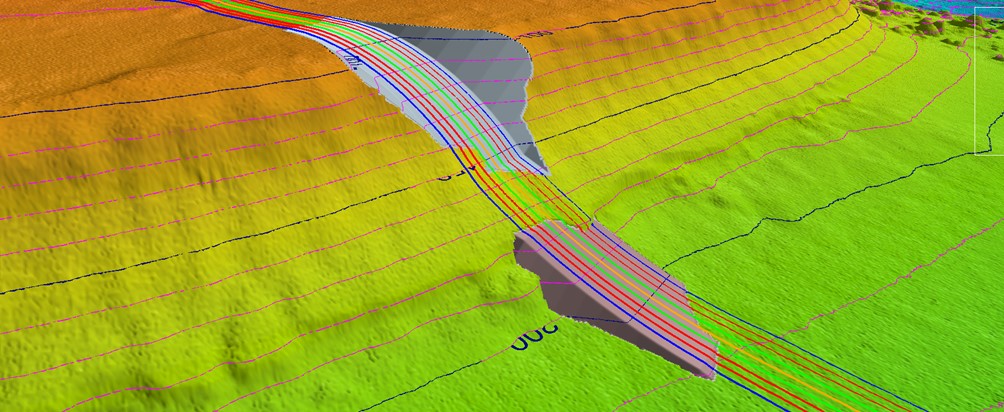PERITUS has experience with subsea cables for both fixed and floating offshore wind, as well as interconnector cables, power cables for oil and gas and fibre optic cables.
Within a typical subsea cable project the following elements are normally required, the level of work needed depends on both the stage of the project whether concept selection through to detailed design or the environment and type of wind farm (fixed or floating).
- Cable route selection
- On-Bottom stability analysis and/or trenching
- Bottom roughness assessment including spanning analysis
- Installation assessment
- Landfall design
- Tie-in design (J-tubes, CPS etc)
In addition and/or based on the findings above some aspects of design can require a more detailed investigation such as:
- Geohazard Analysis
- Risk study considering other external influences and definition of remedial measures
Peritus assists Clients in the development of EPIC documentation such as:
- Invitation to Bid (ITB) Documents
- Materials, fabrication and Construction Specifications
Peritus has developed cable engineering capabilities and a team of experienced people in a global network who have dealt with all types of cable design:
Within the Peritus organisation the cables team capabilities include:
- Armour Sizing
- Material Selection
- Dynamic Cable Design
- Design Code and Acceptance Criteria
- Freespan Design
- Crossing Design
- Bottom Roughness
- Routing
- On-bottom stability
- Geohazard interaction
- Flexible pipelines and umbilicals
- Landfall Design
- Ice Interaction
- Reliability
- Specification Preparation
- Cost Estimation
- Installation Procedures and Manuals Preparation
- Operation and Maintenance Procedures and Manuals Preparation
- Emergency Procedures manuals
- Decommissioning, Abandonment and Recovery Design
- Installation and construction Hazard identification
Design Code and Acceptance Criteria
Our global reach means we have an in depth understanding of all internationally recognised codes and can assist Clients with code selection for areas where local regulations do not dictate.
There have been occasions where it has been necessary to either go beyond the guidance presented within the code or to investigate a solution outside of the scope of the codes guidance, within this field Peritus employees have both investigated and proposed solutions which have been reviewed and approved by independent 3rd parties / code verification bodies or have acted as 3rd party verification bodies to aid another company with finding a solution to a given problem.
Routing
Having experience in installing pipelines, cables and structures in water depths in excess of 2000m where accuracy and weight are key issues, or routing up and down escarpments with multiple fault lines and mudslides where having a detailed understanding of how these features interact with the cable and what the maximum slopes the vessel is capable of installing on.
Freespan Design
Over recent years optimising the allowable span lengths to aid with installation and also to review an already operating cable has become something with which Peritus are entirely familiar.
Peritus employees’ experience is not limited to just the design phase: offshore real-time span analysis and acceptance or rectification work has been performed both during installation and during the operation of pipelines and cables round the world.
Operational pipelines and cables located in areas of moving seabed features such as sand waves or in areas prone to cyclone or typhoon environmental loading have also been investigated and solutions found to allow for the minimum amount of intervention to be performed so as to not impact the operation of the pipeline has also been performed.
Bottom Roughness
With the use of either general finite element packages such as Ansys and Abaqus or special purpose bottom roughness packages such as SAGE® and SIMLA® either a 2D seabed profile or the full 3D seabed where the cable is planned to be installed can be modelled and it is possible to predict where the cable is prone to excessively long or highly stressed spans. For long spans a fatigue analysis can be performed and, if the total amount of fatigue is less than the allowable, then the spans can remain, however if the spans exceed the allowable fatigue limit and/or are over stressed then different mitigation methods can be investigated and analysed within the packages in order to determine the best solution for the cable.
Bundle Design
Peritus employees have a large amount of experience with the design, fabrication and installation of bundles within the North Sea.
Additional experience has been gained investigating the use of bundles within directional drilling scenarios, high temperature/ultra high pressure and ice/arctic environments.
Landfall Design
From basic pre-feed investigations and high level cost estimates through to detailed finite element modelling, Peritus are familiar with all landfall designs including HDD, Open cut and micro tunnelling.
Ice Interaction
With oil and gas being found in remote areas of the world where ice is present either all year round or during the winter there are some key additional analysis which need to be investigated and where possible either routed around or avoided by burial.
- Strudel Scour – Strudel scour forms when ice melts and rivers of water create a hole in the ice where the water flows down into an under-ice river. The water, as it moves downwards, has significant velocity and therefore the ability to erode away large sections of the seabed.
- Stamuka – Stamuka or ice ridges are one of the more complex ice phenomena as they are made up of crushed blocks of ice and therefore understanding their density and its interaction with the seabed not simple. Stamuka occur where floating ice starts to pile up and comes into contact with the seabed, some stamuka have been recorded at approximately 20m in height and as such can apply a large force downwards onto the soil, this can either directly displace the pipe downwards if it is located on the stamuka and/or move the pipeline sideways if located near to the pipeline.
- Iceberg scour forms another major area for cable design and like stamuka requires detailed investigation into area specific phenomenon. Shore/Island approaches is another area where innovative solutions are required as ice tends to pile up at the shore line or on the defences round an island and therefore conventional shore approaches are not always practical and possible. Frost and Thaw is more of a problem for onshore designs, however in some of the shallow offshore and short onshore sections which can be associated with offshore cable, design this annual cyclic even can with time have an adverse effect on the system as the soil properties change over time and the influence of the cable on the surround soil with time can weaken the surrounding soil leading to events like upheaval buckling.
Peritus employees have worked on all aspects of ice interaction and have performed both reliability/probability based analysis and as well as detailed pipe-soil and soil-ice interaction analysis.
Geohazard Assessment
Surface fault movements can have serious consequences on cables which cross them. Normal and reverse faults introduce spans which will need to be investigated and compared to allowable, however it is the strike-slip faults that require special attention as the fault plates move they can compress the cable.
Debris and turbidity flows are triggered when underwater landslides occur and are usually triggered by earthquakes and are made up of the sediment that formed the land slide. Peritus employees have significant experience with debris and turbidity flows having had to route two pipelines down and up seabed slopes with gradients up to 14 degrees. Finite element analysis concluded how near to the bottom of these flows cables could be routed as well as calculating how near to the top route curves could be placed to avoid pulling out route bends.
Probabilistic Seismic Hazard assessment and Fault displacement
Probabilistic fault displacement analysis can be greatly improved if a geophysical survey is performed, this allows for a more accurate understanding of the magnitude and likely trigger mechanism of the faults. Peritus employees have experience in performing fault and geohazard assessments and also have experience with calculating maximum fault magnitudes for given return periods.
Specification Preparation
Having specifications that are appropriate and tailored for each individual project is key to getting both value for money and the correct quality of product.
Peritus employees have significant experience in the production of specifications for design, procurement, construction and maintenance for most cable projects around the world. With access to highly experienced engineers in different locations being able to pool resources as well as understanding the Client’s needs is a key part of Peritus.
Installation Procedures and Manuals Preparation
Peritus employees have gained experience installing cables across the world and have worked as Client representatives offshore, installation contractors and third-party verification bodies, therefore are well placed to write and/or review installation procedures and manuals to ensure that the installation is performed in the safest, quickest and best method.
Operation and Maintenance Procedures and Manuals Preparation
As with the installation procedures and manuals having had personnel who have worked for all the different parties likely to be involved in these operations, Peritus employees are experienced in producing and/or reviewing these documents so that the safest, most efficient, most cost-effective and best solution is available for each specific operation.
The primary Subsea Cable analysis tools used by PERITUS are:
- DNV FATFREE
- DNV Stable Lines
- Sage 2D
- Sage 3D
- Orcaflex
- Orcalay
- Mathcad
- SIMLA
- Geoline 3D
- Fledermaus
- AGA/PRCI Stability
- Abaqus
- Ansys
- Geocalc
The primary internally created and verified Cable analysis tools used by PERITUS are:
- In house Mathcad
- DNV E305 Stability
- DNV GL 13 and RP F111 Trawl Impact
- Linear wave theory selection and velocities
- In house FEA software (e.g. based in Ansys / Abaqus)
- Seabed Bottom roughness
- Ice interaction (Stamuka and scour)
- Fishing gear interaction
- Anchor interaction
- Impact assessment
In addition to discipline engineering roles, Peritus can and has provided Project Management Services in the form of provision of owners engineering teams, supervising the EPCIC contractors during Develop and Execute. Peritus are able to use their own management and project support systems if required. Peritus’ Management Systems are certified to ISO 9001.




